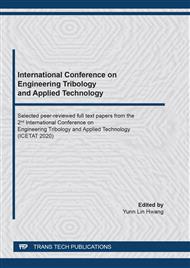p.1
p.7
p.13
p.19
p.27
p.33
p.39
p.47
Design of the Surface Powder Removing Device for the Wire Coil Used in the Screw or Nut Manufacturing Process
Abstract:
Steel wire coil is the raw material for the screw or nut manufacturing process. It’s common that the surface of the wire is covered with wire drawing powder. Wire drawing powder is necessary and served as the solid lubricant while drawing the wire. However, it’ll be flushed out by the forming oil during the screw or nut manufacturing process. The mixing of the forming oil and the wire drawing powder makes the oil more viscous and generates more sludge. In this paper, we propose a very promising approach to solving the above-mentioned problem. A surface powder removing device with an internal helical brush installed inside to wipe out the wire drawing powder. The performance of this powder removing device was evaluated on the cleanness of the wire surface and the quality of the oil. Results show no damage was observed with the hair diameter equals to 0.08 mm. Almost 100% of the wire surface powder wire surface was removed and the oil quality is 6 times better than that without using this device.
Info:
Periodical:
Pages:
47-52
Citation:
Online since:
November 2021
Authors:
Price:
Сopyright:
© 2021 Trans Tech Publications Ltd. All Rights Reserved
Share:
Citation:


